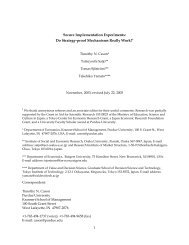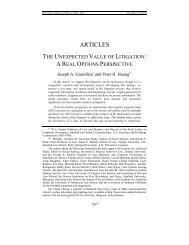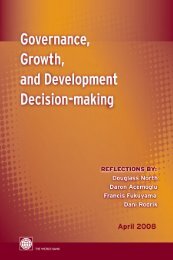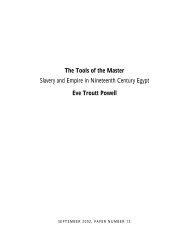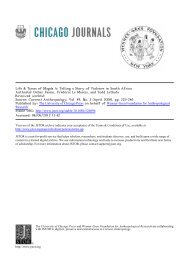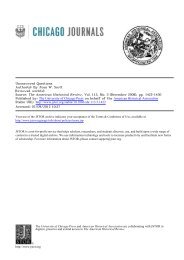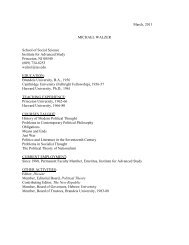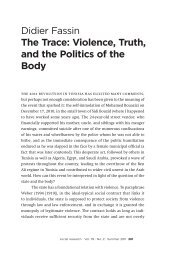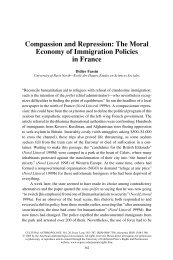Peter H. Huang Harold E. Kohn Chair Professor of Law James ...
Peter H. Huang Harold E. Kohn Chair Professor of Law James ...
Peter H. Huang Harold E. Kohn Chair Professor of Law James ...
Create successful ePaper yourself
Turn your PDF publications into a flip-book with our unique Google optimized e-Paper software.
Emotional Impact Analysis<br />
Zerbe’s approach deals effectively and thoroughly with several arguments against policy makers<br />
taking into account moral sentiments. 246 A particular concern with including moral sentiments is double<br />
counting. 247 Another concern with including moral sentiments is an invariance claim that non-<br />
paternalistic altruistic moral sentiments are unimportant because they simply reinforce those decisions<br />
that would be made in their absence. 248 Zerbe finds that arguments against policy makers taking into<br />
account moral sentiments are incorrect or unpersuasive. Although Zerbe’s approach focuses on moral<br />
sentiments, Zerbe notes that moral sentiments can include immoral sentiments, where people feel such<br />
negative affect as anger, envy, hatred, jealousy, or vengeance towards others.<br />
B. Amoral Sentiments<br />
Upon a moment’s reflection, it becomes clear that Zerbe’s moral sentiments are paradigmatic<br />
examples <strong>of</strong> what this Article has termed positive emotional impacts. Emotional impacts can arise from<br />
ethical or income distributional concerns. 249 But emotional impacts do not have to be moral sentiments or<br />
immoral sentiments, because emotions do not have to arise from a moral or immoral source. For<br />
example, in a sample <strong>of</strong> 909 employed women, commuting to and from their work produced the lowest<br />
levels <strong>of</strong> retrospective well-being out <strong>of</strong> a list <strong>of</strong> 19 activities. 250 In other words, stress from daily<br />
commuting is bona fide affective cost which can be quite large, 251 but not a moral sentiment or an<br />
immoral sentiment. Commuters may feel anger towards their fellow commuters for clogging up roads,<br />
245<br />
See e.g., CHRISTOPHER D. STONE. SHOULD TREES HAVE LEGAL STANDING AND OTHER ESSAYS ON LAW, MORALS<br />
AND THE ENVIRONMENT (1996).<br />
246<br />
See generally Paul R. Milgrom, Is Sympathy an Economic Value? Philosophy, Economics and the Contingent<br />
Valuation Method, in CONTINGENT VALUATION: A CRITICAL ASSESSMENT 417 (Jerry Hausman ed., 1993); Paul R.<br />
Milgrom, Cost-benefit Analysis, Bounded Rationality and the Contingent Valuation Method, Stanford Center for<br />
Economic Policy Research Publication No. 316 (1992) (unpublished manuscript); and Sidney G. Winter, A Simple<br />
Remark on the Second Optimality Theorem <strong>of</strong> Welfare Economics, 1 J. ECON. THEORY 99 (1969).<br />
247<br />
<strong>Peter</strong> A. Diamond & Jerry A. Hausman, Contingent Valuation: Is Some Number Better Than No Number?, J.<br />
ECON. PERSP ., Autumn 1994, at 45, 55 (voicing this double counting concern); and Kenneth E. McConnell, Does<br />
Altruism Undermine Existence Value?, 32 J. ENVTL. ECON. & MGMT. 22, 23, 29 (1997) (refining this concern<br />
properly to just non-paternalistic altruism).<br />
248<br />
McConnell, supra note 247, at 27 (stating this invariance claim).<br />
249<br />
CAROL GRAHAM & STEFANO PETTINATO, HAPPINESS & HARDSHIP: OPPORTUNITY AND INSECURITY IN NEW<br />
MARKET ECONOMIES (2002).<br />
250<br />
Daniel Kahneman et al., A Survey Method for Characterizing Daily Life Experience: The Day Reconstruction<br />
Method, 306 SCI. 1776, 1777 tbl.1, 1779 fig.3 (2004).<br />
40



